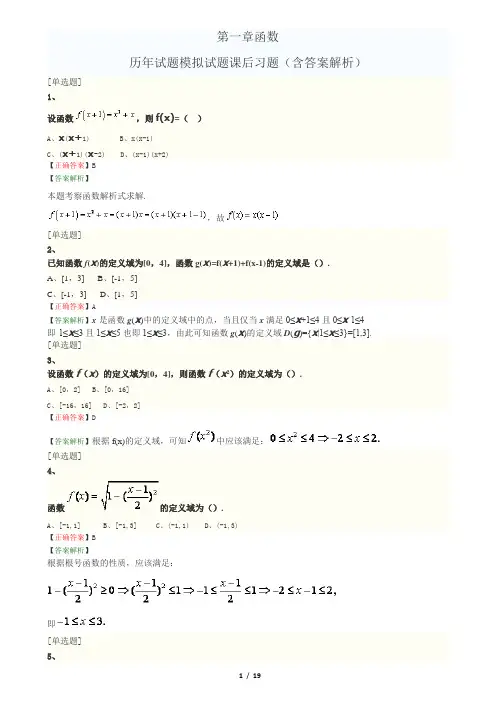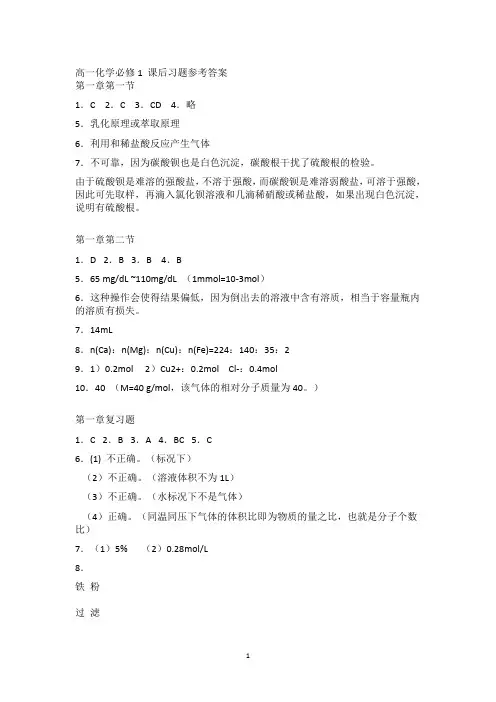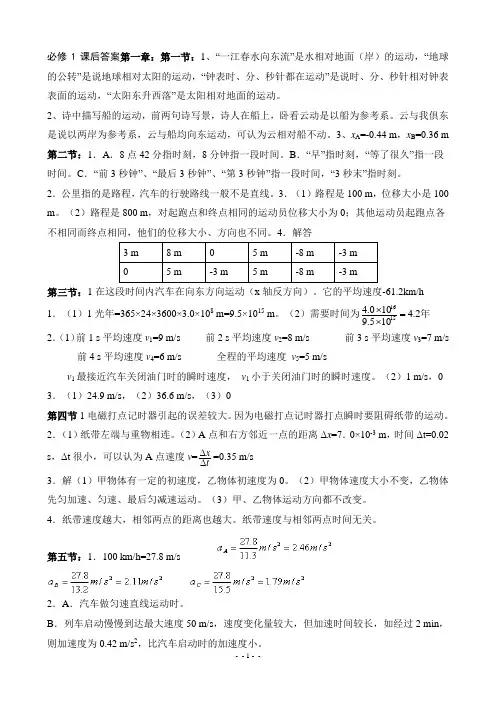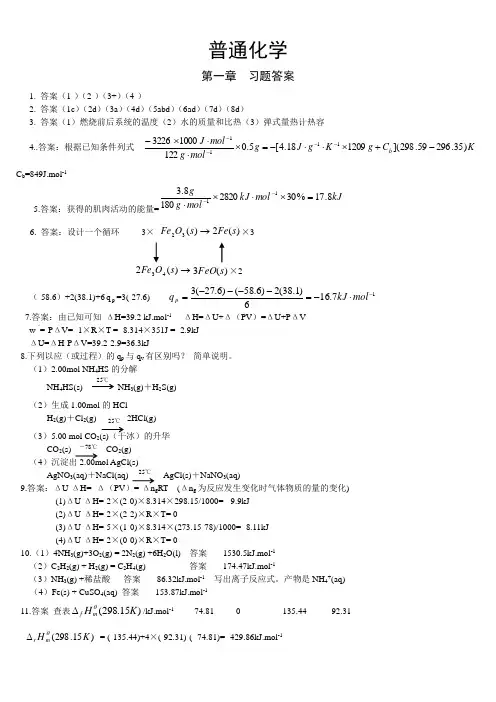1.第一章课后习题及答案
《高等数学一》第一章-函数--课后习题(含答案解析)

第一章函数历年试题模拟试题课后习题(含答案解析)[单选题]1、设函数,则f(x)=()A、x(x+1)B、x(x-1)C、(x+1)(x-2)D、(x-1)(x+2)【正确答案】B【答案解析】本题考察函数解析式求解.,故[单选题]2、已知函数f(x)的定义域为[0,4],函数g(x)=f(x+1)+f(x-1)的定义域是().A、[1,3]B、[-1,5]C、[-1,3]D、[1,5]【正确答案】A【答案解析】x是函数g(x)中的定义域中的点,当且仅当x满足0≤x+1≤4且0≤x-1≤4即-1≤x≤3且1≤x≤5也即1≤x≤3,由此可知函数g(x)的定义域D(g)={x|1≤x≤3}=[1,3]. [单选题]3、设函数f(x)的定义域为[0,4],则函数f(x2)的定义域为().A、[0,2]B、[0,16]C、[-16,16]D、[-2,2]【正确答案】D【答案解析】根据f(x)的定义域,可知中应该满足:[单选题]4、函数的定义域为().A、[-1,1]B、[-1,3]C、(-1,1)D、(-1,3)【正确答案】B【答案解析】根据根号函数的性质,应该满足:即[单选题]写出函数的定义域及函数值().A、B、C、D、【正确答案】C【答案解析】分段函数的定义域为各个分段区间定义域的并集,故D=(-∞,-1]∪(-1,+∞).[单选题]6、设函数,则对所有的x,则f(-x)=().A、B、C、D、【正确答案】A【答案解析】本题考察三角函数公式。
.[单选题]7、设则=().A、B、C、D、【正确答案】B【答案解析】令则,故[单选题]8、则().A、B、C、D、【正确答案】D【答案解析】[单选题]9、在R上,下列函数中为有界函数的是().xA、eB、1+sin xC、ln x【正确答案】B【答案解析】由函数图像不难看出在R上e x,lnx,tanx都是无界的,只有1+sinx可能有界,由于|sinx|≤1,|1+sinx|≤1+|sinx|≤2所以有界.[单选题]10、不等式的解集为().A、B、C、D、【正确答案】D【答案解析】[单选题]11、().A、B、C、D、【正确答案】A【答案解析】根据二角和公式,[单选题]12、函数的反函数是().A、B、C、D、【正确答案】A【答案解析】由所以,故.[单选题]13、已知则().A、B、C、D、【正确答案】C【答案解析】[单选题]14、已知为等差数列,,则().A、-2B、1C、3D、7【正确答案】A因为同理可得:故d=a4-a3=-2.[单选题]15、计算().A、B、C、D、【正确答案】A【答案解析】根据偶次根式函数的意义,可知,故[单选题]16、计算().A、0B、1C、2D、4【正确答案】C【答案解析】原式=[单选题]将函数|表示为分段函数时,=().A、B、C、D、【正确答案】B【答案解析】由条件[单选题]18、函数f(x)=是().A、奇函数B、偶函数C、有界函数D、周期函数【正确答案】C【答案解析】易知不是周期函数,,即不等于,也不等于,故为非奇、非偶函数.,故为有界函数.[单选题]19、函数,则的定义域为().A、[1,5]C、(1,5]D、[1,5)【正确答案】A【答案解析】由反正切函数的定义域知:,故定义域为[1,5].[单选题]20、下列等式成立的是()A、B、C、D、【正确答案】B【答案解析】A中(e x)2=,C中,D中[单选题]21、下列函数为偶函数的是()A、y=xsinxB、y=xcosxC、y=sinx+cosxD、y=x(sinx+cosx)【正确答案】A【答案解析】sinx是奇函数,cosx是偶函数。
大学物理课后习题1第一章答案

习题11.1选择题(1)一运动质点在某瞬时位于矢径),(y x r的端点处,其速度大小为()(A)dtdr (B)dtr d (C)dtr d || (D)22)()(dtdy dt dx +答案:(D)。
(2)一质点作直线运动,某时刻的瞬时速度s m v /2=,瞬时加速度2/2s m a -=,则一秒钟后质点的速度()(A)等于零(B)等于-2m/s (C)等于2m/s (D)不能确定。
答案:(D)。
(3)一质点沿半径为R 的圆周作匀速率运动,每t 秒转一圈,在2t 时间间隔中,其平均速度大小和平均速率大小分别为()(A)t R t R ππ2,2(B)tRπ2,0(C)0,0(D)0,2tRπ答案:(B)。
(4)质点作曲线运动,r表示位置矢量,v 表示速度,a 表示加速度,S 表示路程,τa 表示切向加速度,下列表达式中,()①a t = d /d v ,②v =t r d /d ,③v =t S d /d ,④τa t =d /d v.(A)只有①、④是对的.(B)只有②、④是对的.(C)只有②是对的.(D)只有③是对的.答案:(D)。
(5)一质点在平面上作一般曲线运动,其瞬时速度为v,瞬时速率为υ,某一时间内的平均速度为v,平均速率为v ,它们之间的关系必定有:()(A)vv v,v == (B)v v v,v =≠ (C)vv v,v ≠≠ (D)vv v,v ≠= 答案:(D)。
1.2填空题(1)一质点,以1-⋅s m π的匀速率作半径为5m 的圆周运动,则该质点在5s 内,位移的大小是;经过的路程是。
答案:10m;5πm。
(2)一质点沿x 方向运动,其加速度随时间的变化关系为a=3+2t (SI),如果初始时刻质点的速度v 0为5m ·s -1,则当t 为3s 时,质点的速度v=。
答案:23m·s -1.(3)一质点从静止出发沿半径R=1m 的圆周运动,其角加速度随时间t 的变化规律是α=12t 2-6t (SI),则质点的角速度ω=__________________;切向加速度τa =_________________.答案:4t 3-3t 2(rad/s),12t 2-6t (m/s 2)(4)一质点作直线运动,其坐标x 与时间t 的关系曲线如题1.2(4)图所示.则该质点在第___秒瞬时速度为零;在第秒至第秒间速度与加速度同方向.题1.2(4)图答案:3,36;(5)一质点其速率表示式为v s =+12,则在任一位置处其切向加速度a τ为。
高一化学必修1 课后习题参考答案

高一化学必修1 课后习题参考答案第一章第一节1.C 2.C 3.CD 4.略5.乳化原理或萃取原理6.利用和稀盐酸反应产生气体7.不可靠,因为碳酸钡也是白色沉淀,碳酸根干扰了硫酸根的检验。
由于硫酸钡是难溶的强酸盐,不溶于强酸,而碳酸钡是难溶弱酸盐,可溶于强酸,因此可先取样,再滴入氯化钡溶液和几滴稀硝酸或稀盐酸,如果出现白色沉淀,说明有硫酸根。
第一章第二节1.D 2.B 3.B 4.B5.65 mg/dL ~110mg/dL (1mmol=10-3mol)6.这种操作会使得结果偏低,因为倒出去的溶液中含有溶质,相当于容量瓶内的溶质有损失。
7.14mL8.n(Ca):n(Mg):n(Cu):n(Fe)=224:140:35:29.1)0.2mol 2)Cu2+:0.2mol Cl-:0.4mol10.40 (M=40 g/mol,该气体的相对分子质量为40。
)第一章复习题1.C 2.B 3.A 4.BC 5.C6.(1) 不正确。
(标况下)(2)不正确。
(溶液体积不为1L)(3)不正确。
(水标况下不是气体)(4)正确。
(同温同压下气体的体积比即为物质的量之比,也就是分子个数比)7.(1)5% (2)0.28mol/L8.铁粉过滤FeSO4溶液稀硫酸过滤FeSO4溶液蒸发结晶9.1.42 g,操作步骤略。
第二章第一节1.②⑧①④⑤⑥⑦⑩⑨2.树状分类法略5.分散系分散质粒子大小主要特征举例浊液>100 nm不稳定,不均一泥浆水溶液<1 nm稳定,均一饱和NaCl溶液胶体1~100 nm较稳定,均一6.BD7.胶体区别于其他分散系得本质特征是胶体粒子的大小在1~100nm范围。
胶体的应用,例如明矾净水、豆浆加石膏成豆腐、静电除尘、江河入海口易形成沙洲、血液透析、饱和氯化铁溶液用于应急性止血等。
第二章第二节1.水溶液熔融状态电离阴阳离子阳离子H+ 阴离子OH-金属离子或铵根离子酸根离子H+ + OH-=H2O2.两种电解质在溶液中相互交换离子的反应生成难溶物、易挥发物质、弱电解质3.C 4.C 5.C 6.B 7.D8.(1) NaOH=Na++OH- (2) CuCl2=Cu2++2Cl-(3) Fe2(SO4)3=2Fe3++3SO42- (4) Ba(NO3)2=Ba2++2NO3-9.(1) SO42-+Ba2+=BaSO4 (2) 2Al+3Hg2+=3Hg+2Al3+(3) CO32-+2H+=H2O+CO2 (4) 不反应。
高中物理必修1课后习题答案(打印版)

必修1课后答案第一章:第一节:1、“一江春水向东流”是水相对地面(岸)的运动,“地球的公转”是说地球相对太阳的运动,“钟表时、分、秒针都在运动”是说时、分、秒针相对钟表表面的运动,“太阳东升西落”是太阳相对地面的运动。
2、诗中描写船的运动,前两句诗写景,诗人在船上,卧看云动是以船为参考系。
云与我俱东是说以两岸为参考系,云与船均向东运动,可认为云相对船不动。
3、x A =-0.44 m ,x B =0.36 m第二节:1.A .8点42分指时刻,8分钟指一段时间。
B .“早”指时刻,“等了很久”指一段时间。
C .“前3秒钟”、“最后3秒钟”、“第3秒钟”指一段时间,“3秒末”指时刻。
2.公里指的是路程,汽车的行驶路线一般不是直线。
3.(1)路程是100 m ,位移大小是100 m 。
(2)路程是800 m ,对起跑点和终点相同的运动员位移大小为0;其他运动员起跑点各不相同而终点相同,他们的位移大小、方向也不同。
4.解答3 m8 m 0 5 m -8 m -3 m 0 5 m -3 m 5 m -8 m -3 m第三节:1在这段时间内汽车在向东方向运动(x 轴反方向)。
它的平均速度-61.2km/h1.(1)1光年=365×24×3600×3.0×108 m=9.5×1015 m 。
(2)需要时间为16154.010 4.29.510⨯=⨯年 2.(1)前1 s 平均速度v 1=9 m/s 前2 s 平均速度v 2=8 m/s 前3 s 平均速度v 3=7 m/s 前4 s 平均速度v 4=6 m/s 全程的平均速度 v 5=5 m/sv 1最接近汽车关闭油门时的瞬时速度, v 1小于关闭油门时的瞬时速度。
(2)1 m/s ,03.(1)24.9 m/s ,(2)36.6 m/s ,(3)0第四节1电磁打点记时器引起的误差较大。
因为电磁打点记时器打点瞬时要阻碍纸带的运动。
《普通化学》课后习题答案

普通化学第一章 习题答案1. 答案(1-)(2-)(3+)(4-)2. 答案(1c )(2d )(3a )(4d )(5abd )(6ad )(7d )(8d )3. 答案(1)燃烧前后系统的温度(2)水的质量和比热(3)弹式量热计热容4..答案:根据已知条件列式 K C g K g J g molg mol J b )35.29659.298](120918.4[5.0122100032261111-+⨯⋅⋅-=⨯⋅⋅⨯----- C b =849J.mol -15.答案:获得的肌肉活动的能量=kJ mol kJ mol g g8.17%3028201808.311=⨯⋅⨯⋅--6. 答案:设计一个循环 3× )(2)(32s Fe s O Fe →×3→)(243s O Fe )(3s FeO ×2(-58.6)+2(38.1)+6p q =3(-27.6) 17.166)1.38(2)6.58()6.27(3-⋅-=----=mol kJ q p7.答案:由已知可知 ΔH=39.2 kJ.mol -1 ΔH=ΔU+Δ(PV )=ΔU+P ΔVw ‘=-P ΔV= -1×R ×T = -8.314×351J = -2.9kJ ΔU=ΔH-P ΔV=39.2-2.9=36.3kJ8.下列以应(或过程)的q p 与q v 有区别吗? 简单说明。
(1)2.00mol NH 4HS 的分解NH 4HS(s) NH 3(g)+H 2S(g) (2)生成1.00mol 的HCl H 2(g)+Cl 2(g) 2HCl(g) (3)5.00 mol CO 2(s)(干冰)的升华CO 2(s)CO 2(g) (4)沉淀出2.00mol AgCl(s) AgNO 3(aq)+NaCl(aq) AgCl(s)+NaNO 3(aq)9.答案:ΔU-ΔH= -Δ(PV )=-Δn g RT (Δn g 为反应发生变化时气体物质的量的变化) (1)ΔU-ΔH=-2×(2-0)×8.314×298.15/1000= - 9.9kJ(2)ΔU-ΔH=-2×(2-2)×R ×T= 0(3)ΔU-ΔH=-5×(1-0)×8.314×(273.15-78)/1000= -8.11kJ (4)ΔU-ΔH=-2×(0-0)×R ×T= 010.(1)4NH 3(g)+3O 2(g) = 2N 2(g) +6H 2O(l) 答案 -1530.5kJ.mol -1(2)C 2H 2(g) + H 2(g) = C 2H 4(g) 答案 -174.47kJ.mol -1 (3)NH 3(g) +稀盐酸 答案 -86.32kJ.mol -1 写出离子反应式。
中级会计职称第1章课后习题及答案

中级会计职称《中级会计实务》第一章课后练习题及答案第一章总论一、单项选择题1.下列项目中,不属于财务报告目标的是()。
A.向财务报告使用者提供与企业财务状况有关的会计信息B.向财务报告使用者提供与企业现金流量有关的会计信息C.反映企业管理层受托责任履行情况D.满足企业内部管理需要答案:D解析:财务报告的目标是向财务报告使用者提供与企业财务状况、经营成果和现金流量等有关的会计信息,反映企业管理层受托责任履行情况,有助于财务报告使用者作出经济决策。
财务报告目标不是满足企业内部管理的需要。
2.会计基本假设不包括()A.会计主体假设B.持续经营假设C.会计分期假设D.实物计量假设答案:D解析:会计基本假设包括会计主体假设、持续经营假设、会计分期假设和货币计量假设。
不包括实物计量假设。
3.()不是企业会计确认计量和报告选择货币计量的原因。
A.货币是商品的一般等价物B.货币是衡量一般商品的共同尺度C.只能从一个侧面反映企业的生产经营情况D.货币是价值尺度和流通手段答案:C解析:货币是商品的一般等价物,是衡量一般商品价值的共同尺度,具有价值尺度、流通手段、储藏手段和支付手段等特点。
4.下列关于权责发生制的表述中不正确的是()。
A.凡是当期已经实现的收入和应当负担的费用,无论款项是否收付都应当作为当期的收入和费用B.凡是不属于当期的收入和费用,即使款项已在当期收付,也不应当作为当期的收入和费用C.款项已收到,但销售并未实现,收到款项时确认收入D.费用已经发生,但款项并没有支付,费用发生时确认费用答案:C解析:根据权责发生制要求,应该是在销售实现时确认收入,而不是收到款项时确认收入。
5.下列项目中,不违背会计核算可比性要求的是()。
A.当固定资产价值恢复时,将以前年度计提的减值准备转回B.由于利润计划完成情况不佳,将以前年度计提的坏账准备全额转回C.固定资产达到预定可使用状态之后,利息费用继续资本化D.某项专利技术已经陈旧,已不能为企业带来经济利益。
(完整版)人教版高一化学必修一课后习题答案
《化学(必修)1》 课后习题参考答案第一章第一节 p101.C 2.C 3.CD 4.略5.乳化原理或萃取原理 6.利用和稀盐酸反应产生气体7.不可靠,因为碳酸钡也是白色沉淀,碳酸根干扰了硫酸根的检验。
由于硫酸钡是难溶的强酸盐,不溶于强酸,而碳酸钡是难溶弱酸盐,可溶于强酸,因此可先取样,再滴入氯化钡溶液和几滴稀硝酸或稀盐酸,如果出现白色沉淀,说明有硫酸根。
第一章第二节 p171.D 2.B 3.B 4.B5.65 mg/dL ~110mg/dL (1mmol=10-3mol )6.这种操作会使得结果偏低,因为倒出去的溶液中含有溶质,相当于容量瓶内的溶质有损失。
7.14mL8.n(Ca):n(Mg):n(Cu):n(Fe)=224:140:35:2 9.1)0.2mol 2)Cu2+:0.2mol Cl-:0.4mol 10.40 (M=40 g/mol ,该气体的相对分子质量为40。
)第一章复习题 p191.C 2.B 3.A 4.BC 5.C6.(1) 不正确。
(标况下或没有明确O2的状态)(2)不正确。
(溶液体积不为1L )或氢氧化钠加入水中后,形成溶液的体积不能确定 (3)不正确。
(水标况下不是气体)或水在常温下是液体(4)正确。
(同温同压下气体的体积比即为物质的量之比,也就是分子个数比) 7.(1)5% (2)0.28mol/L 8.9.1.42 g , 操作步骤 (1)计算所需硫酸钠的质量,m (硫酸钠)=0.2mol/L×0.05L×142g/mol=0.56g(2) 称量(3)溶解并冷却至室温(4)转移至50ml 容量瓶,并洗涤小烧杯2次~3次,将洗涤液转移到容量瓶中,轻轻摇动容量瓶,使溶液混合均匀铁 粉 过 滤Fe 、CuFeSO 4溶液稀硫酸过 滤FeSO 4溶液蒸发 结晶第二章第一节p291.②⑧①④⑤⑥⑦⑩⑨2.树状分类法略6.BD7.胶体区别于其他分散系得本质特征是胶体粒子的大小在1~100nm范围。
高中物理(新人教版)选择性必修一课后习题:第一章 动量和能量的综合应用(课后习题)【含答案及解析】
习题课:动量和能量的综合应用课后篇巩固提升必备知识基础练1.如图所示,木块A 、B 的质量均为2 kg,置于光滑水平面上,B 与一轻质弹簧的一端相连,弹簧的另一端固定在竖直挡板上,当A 以4 m/s 的速度向B 撞击时,由于有橡皮泥而粘在一起运动,那么弹簧被压缩到最短时,弹簧具有的弹性势能大小为( )A.4 JB.8 JC.16 JD.32 J、B 在碰撞过程中动量守恒,碰后粘在一起共同压缩弹簧的过程中机械能守恒。
由碰撞过程中动量守恒得m A v A =(m A +m B )v ,代入数据解得v=m A vAm A +m B=2 m/s,所以碰后A 、B 及弹簧组成的系统的机械能为12(m A +m B )v 2=8 J,当弹簧被压缩至最短时,系统的动能为0,只有弹性势能,由机械能守恒得此时弹簧的弹性势能为8 J 。
2.(多选)如图甲所示,在光滑水平面上,轻质弹簧一端固定,物体A 以速度v 0向右运动压缩弹簧,测得弹簧的最大压缩量为x 。
现让弹簧一端连接另一质量为m 的物体B (如图乙所示),物体A 以2v 0的速度向右压缩弹簧,测得弹簧的最大压缩量仍为x ,则( )A.A 物体的质量为3mB.A 物体的质量为2mC.弹簧达到最大压缩量时的弹性势能为32mv 02 D.弹簧达到最大压缩量时的弹性势能为m v 02,设物体A 的质量为M ,由机械能守恒定律可得,弹簧压缩量为x 时弹性势能E p =12Mv 02;对题图乙,物体A 以2v 0的速度向右压缩弹簧,A 、B 组成的系统动量守恒,弹簧达到最大压缩量时,A 、B 二者速度相等,由动量守恒定律有M×(2v 0)=(M+m )v ,由能量守恒定律有E p =12M×(2v 0)2-12(M+m )v 2,联立解得M=3m ,E p =12M×v 02=32mv 02,A 、C 正确,B 、D 错误。
3.如图所示,带有半径为R 的14光滑圆弧的小车的质量为m 0,置于光滑水平面上,一质量为m 的小球从圆弧的最顶端由静止释放,求小球离开小车时,小球和小车的速度。
第一章课后习题答案
第一章课后习题答案1、5个女生,7个男生进行排列,(a) 若女生在一起有多少种不同的排列?(b) 女生两两不相邻有多少种不同的排列?(c) 两男生A和B之间正好有3个女生的排列是多少?解:(a) 若女生在一起,可将5个女生看作一个整体参与排列,有8!种方式,然后5个女生再进行排列,有5!种方式,根据乘法法则,共有8!5!种方式。
(b) 若女生两两不相邻,可将7个男生进行排列,有7!种方式,考虑到两个男生之间的6个位置和两头的2个位置,每个位置安排一个女生均符合题意,故从中选出5个位置,然后5个女生再进行排列,按顺序安排到这5个位置,有C(8, 5)5!种方式,根据乘法法则,共有7!C(8, 5)5!=7!P(8, 5)种方式。
(c) 若两男生A和B之间正好有3个女生,可以按照顺序操作如下:首先将女生分为两组,一组3人,一组2人,有C(5, 3)种方式;将男生A和B看作一个整体,加上其他5个男生,2人一组的女生进行排列,有8!种方式;将3人一组的女生安排到男生A和B之间进行排列,有3!种方式;男生A和B进行排列,有2!种方式。
根据乘法法则,所求的排列方式为8!C(5, 3)3!2!=8!P(5, 3)2!2、求3000到8000之间的奇整数的数目,而且没有相同的数字。
解:设介于3000到8000之间的奇整数表示为abcd,则a∈{3, 4, 5, 6, 7}, d∈{1, 3, 5, 7, 9},对a进行分类如下:(1) 若a∈{3, 5, 7},则d有4种选取方式,bc有P(8, 2)种方式,根据乘法法则,此类数字有3⨯4⨯P(8, 2)=672个(2) 若a∈{4, 6},则d有5种选取方式,bc仍有P(8, 2)种方式,根据乘法法则,此类数字有2⨯5⨯P(8, 2)=560个根据加法法则,3000到8000之间数字不同的奇整数的数目为672+560=1232个3、证明nC(n-1, r)=(r+1)C(n, r+1),并给出组合解释。
1-第一章X射线物理课后习题答案
第一章 X 射线物理习题一解答1-1 产生X 射线需要哪些条件?答:首先要有产生电子的阴极和被轰击的阳极靶,电子加速的环境条件即在阴极和阳极间建立电位差,为防止阴极和阳极氧化以及电子与中性分子碰撞的数量损失,要制造压强小于4-Pa 的真空环境,为此要有一个耐压、密封的管壳。
1-2 影响X 射线管有效焦点大小的因素有哪些?答:影响有效焦点大小的因素有:灯丝大小、管电压和管电流、靶倾角。
1-3 在X 射线管中,若电子到达阳极靶面的速度为1.5⨯810ms -1,求连续X 射线谱的最短波长和相应的最大光子能量。
答:此题的思路是由动能公式221v m 求出电子的最大动能,此能量也是最大的光子能量,从而求出最短波长。
但当速度可与光速c=3⨯810ms -1相比较时,必须考虑相对论效应,我们可以用下面公式求出运动中电子的质量此题的结果告诉我们,管电压为73.8KV 。
反过来,如果知道管电压,求电子到达阳极靶表面的电子速度时,同样需要考虑相对论效应。
1-4 下面有关连续X 射线的解释,哪些是正确的?A .连续X 射线是高速电子与靶物质轨道电子相互作用的结果;B .连续X 射线是高速电子与靶物质的原子核电场相互作用的结果;C .连续X 射线的最大能量决定于管电压;D .连续X 射线的最大能量决定于靶物质的原子序数;E .连续X 射线的质与管电流无关。
正确答案:B 、C 、E1-5 下面有关标识X 射线的解释,哪些是正确的?A .标识X 射线是高速电子与靶物质轨道电子相互作用的结果;B .标识X 射线的质与高速电子的能量有关;C .标识X 射线的波长由跃迁电子的能级差决定;D .滤过使标识X 射线变硬;E .靶物质原子序数越高,标识X 射线的能量就越大。
正确答案:A 、C 、E1-6 影响X 射线能谱的因素有哪些?答:电子轰击阳极靶产生的X 射线能谱的形状(归一化后)主要由管电压、靶倾角和固有滤过决定。
当然,通过附加滤过也可改变X 射线能谱的形状。
- 1、下载文档前请自行甄别文档内容的完整性,平台不提供额外的编辑、内容补充、找答案等附加服务。
- 2、"仅部分预览"的文档,不可在线预览部分如存在完整性等问题,可反馈申请退款(可完整预览的文档不适用该条件!)。
- 3、如文档侵犯您的权益,请联系客服反馈,我们会尽快为您处理(人工客服工作时间:9:00-18:30)。
第一章1.(Q1) What is the difference between a host and an end system List the types ofend systems. Is a Web server an end systemAnswer: There is no difference. Throughout this text, the words “host” and “end system” are used interchangeably. End systems inc lude PCs, workstations, Web servers, mail servers, Internet-connected PDAs, WebTVs, etc.2.(Q2) The word protocol is often used to describe diplomatic relations. Give anexample of a diplomatic protocol.Answer: Suppose Alice, an ambassador of country A wants to invite Bob, an ambassador of country B, over for dinner. Alice doesn’t simply just call Bob on the phone and say, come to our dinner table now”. Instead, she calls Bob and suggests a date and time. Bob may respond by saying he’s not available that particular date, but he is available another date. Alice and Bob continue to send “messages” back and forth until they agree on a date and time. Bob then shows up at the embassy on the agreed date, hopefully not more than 15 minutes before or after the agreed time. Diplomatic protocols also allow for either Alice or Bob to politely cancel the engagement if they have reasonable excuses.3.(Q3) What is a client program What is a server program Does a server programrequest and receive services from a client programAnswer: A networking program usually has two programs, each running on a different host, communicating with each other. The program that initiates the communication is the client. Typically, the client program requests and receives services from the server program.4.(Q4) List six access technologies. Classify each one as residential access,company access, or mobile access.Answer:1. Dial-up modem over telephone line: residential; 2. DSL over telephone line: residential or small office; 3. Cable to HFC: residential; 4. 100 Mbps switched Etherent: company; 5. Wireless LAN: mobile; 6. Cellular mobile access (for example, 3G/4G): mobile5.(Q5) List the available residential access technologies in your city. For eachtype of access, provide the advertised downstream rate, upstream rate, and monthly price.Answer: Current possibilities include: dial-up (up to 56kbps); DSL (up to 1 Mbps upstream, up to 8 Mbps downstream); cable modem (up to 30Mbps downstream, 2 Mbps upstream.6.(Q7) What are some of the physical media that Ethernet can run overAnswer: Ethernet most commonly runs over twisted-pair copper wire and “thin”coaxial cable. It also can run over fibers optic links and thick coaxial cable.7.(Q8) Dial-up modems, HFC, and DSL are all used for residential access. For eachof these access technologies, provide a range of transmission rates and comment on whether the transmission rate is shared or dedicated.Answer: Dial up modems: up to 56 Kbps, bandwidth is dedicated; ISDN: up to 128 kbps, bandwidth is dedicated; ADSL: downstream channel is .5-8 Mbps, upstream channel is up to 1 Mbps, bandwidth is dedicated; HFC, downstream channel is 10-30 Mbps and upstream channel is usually less than a few Mbps, bandwidth is shared.8.(Q13) Why is it said that packet switching employs statistical multiplexingContrast statistical multiplexing with the multiplexing that takes place in TDM.Answer:In a packet switched network, the packets from different sources flowing on a link do not follow any fixed, pre-defined pattern. In TDM circuit switching, each host gets the same slot in a revolving TDM frame.9.(Q14) Suppose users share a 2Mbps link. Also suppose each user requires 1Mbpswhen transmitting, but each user transmits only 20 percent of the time. (See the discussion of statistical multiplexing in Section .)a.When circuit switching is used, how many users can be supportedb.For the remainder of this problem, suppose packet switching is used. Whywill there be essentially no queuing delay before the link if two or fewer users transmit at the same time Why will there be a queuing delay if three users transmit at the same timec.Find the probability that a given user is transmitting.d.Suppose now there are three users. Find the probability that at any giventime, all three users are transmitting simultaneously. Find the fraction of time during which the queue grows.Answer:a. 2 users can be supported because each user requires half of the linkbandwidth.b.Since each user requires 1Mbps when transmitting, if two or fewer userstransmit simultaneously, a maximum of 2Mbps will be required. Since the available bandwidth of the shared link is 2Mbps, there will be no queuing delay before the link. Whereas, if three users transmit simultaneously, thebandwidth required will be 3Mbps which is more than the available bandwidth of the shared link. In this case, there will be queuing delay before the link.c.Probability that a given user is transmitting =d.Probability that all three users are transmittingsimultaneously. Since the queue grows when all the users are transmitting, the fraction of time during which the queue grows (which is equal to the probability that all three users are transmitting simultaneously) is .10.(Q16) Consider sending a packet from a source host to a destination host overa fixed route. List the delay components in the end-to-end delay. Which of thesedelays are constant and which are variableAnswer:The delay components are processing delays, transmission delays, propagation delays, and queuing delays. All of these delays are fixed, except for the queuing delays, which are variable.11.(Q19) Suppose Host A wants to send a large file to Host B. The path from HostA to HostB has three links, of rates R1 = 250 kbps, R2 = 500 kbps, and R3 = 1Mbps.a.Assuming no other traffic in the network, what is the throughput for thefile transfer.b.Suppose the file is 2 million bytes. Roughly, how long will it take totransfer the file to Host Bc.Repeat (a) and (b), but now with R2 reduced to 200 kbps.Answer:a.250 kbpsb.64 secondsc.200 kbps; 80 seconds12.(P2) Consider the circuit-switched network in Figure . Recall that there aren circuits on each link.a.What is the maximum number of simultaneous connections that can be inprogress at any one time in this networkb.Suppose that all connections are between the switch in the upper-left-handcorner and the switch in the lower-right-hand corner. What is the maximumnumber of simultaneous connections that can be in progressAnswer:a.We can n connections between each of the four pairs of adjacent switches.This gives a maximum of 4n connections.b.We can n connections passing through the switch in the upper-right-handcorner and another n connections passing through the switch in the lower-left-hand corner, giving a total of 2n connections.13.(P4) Review the car-caravan analogy in Section . Assume a propagation speed of50 km/hour.a.Suppose the caravan travels 150 km, beginning in front of one tollbooth,passing through a second tollbooth, and finishing just before a thirdtollbooth. What is the end-to-end delayb.Repeat (a), now assuming that there are five cars in the caravan insteadof ten.Answer: Tollbooths are 150 km apart, and the cars propagate at 50 km/hr, Atollbooth services a car at a rate of one car every 12 seconds.a.There are ten cars. It takes 120 seconds, or two minutes, for the firsttollbooth to service the 10 cars. Each of these cars has a propagation delay of 180 minutes before arriving at the second tollbooth. Thus, all the cars are lined up before the second tollbooth after 182 minutes. The whole process repeats itself for traveling between the second and third tollbooths. Thus the total delay is 364 minutes.b.Delay between tollbooths is 5*12 seconds plus 180 minutes, ., 181minutes.The total delay is twice this amount, ., 362 minutes.14.(P5) This elementary problem begins to explore propagation delay andtransmission delay, two central concepts in data networking. Consider two hosts,A and B, connected by a single link of rate R bps. Suppose that the two hostsare separated by m meters, and suppose the propagation speed along the link is s meters/sec. Host A is to send a packet of size L bits to Host B.a.Express the propagation delay, d , in terms of m and s.b.Determine the transmission time of the packet, d , in terms of L and R.c.Ignoring processing and queuing delays, obtain an expression for theend-to-end delay.d.Suppose Host A begins to transmit the packet at time t = 0. At time t =d , where is the last bit of the packete.Suppose d is greater than d . At time t = d , where is the first bit ofthe packetf.Suppose d is less than d . At time t = d , where is the first bit of thepacketg.Suppose s = *108, L = 100bits, and R = 28kbps. Find the distance m so thatd equals d .Answer:a. d = m/s seconds.b. d = L/R seconds.c. d = (m/s + L/R) seconds.d.The bit is just leaving Host A.e.The first bit is in the link and has not reached Host B.f.The first bit has reached Host B.g.Want15.(P6) In this problem we consider sending real-time voice from Host A to HostB over a packet-switched network (VoIP). Host A converts analog voice to adigital 64 kbps bit stream on the fly. Host A then groups the bits into 56-Byte packets. There is one link between Host A and B; its transmission rate is 500 kbps and its propagation delay is 2 msec. As soon as Host A gathers a packet, it sends it to Host B. As soon as Host B receives an entire packet, it converts the packet’s bits to an analog signal. How much time elapses from the time a bit is created (from the original analog signal at Host A) until the bit is decoded (as part of the analog signal at Host B)Answer: Consider the first bit in a packet. Before this bit can be transmitted, all of the bits in the packet must be generated. This requiresThe time required to transmit the packet isPropagation delay = 2 msec.The delay until decoding is7msec + 896μsec + 2msec = msecA similar analysis shows that all bits experience a delay of msec.16.(P9) Consider a packet of length L which begins at end system A, travels overone link to a packet switch, and travels from the packet switch over a second link to a destination end system. Let d i, s i, and R i denote the length, propagation speed, and the transmission rate of link i, for i= 1, 2. The packet switch delays each packet by d proc. Assuming no queuing delays, in terms of d i, s i, R i, (i = 1,2), and L, what is the total end-to-end delay for the packet Suppose now thepacket Length is 1,000 bytes, the propagation speed on both links is * 108m/s, the transmission rates of both links is 1 Mbps, the packet switch processing delay is 2 msec, the length of the first link is 6,000 km, and the length of the last link is 3,000 km. For these values, what is the end-to-end delayAnswer: The first end system requires L/R1to transmit the packet onto the first link; the packet propagates over the first link in d1/s1; the packet switch addsa processing delay of d proc; after receiving the entire packet, the packet switchrequires L/R2to transmit the packet onto the second link; the packet propagates over the second link in d2/s2. Adding these five delays givesd end-end = L/R1 + L/R2 + d1/s1 + d2/s2 + d procTo answer the second question, we simply plug the values into the equation to get 8 + 8 + 24 + 12 + 2 = 54 msec.17.(P10) In the above problem, suppose R1 = R2 = R and d proc= 0. Further suppose thepacket switch does not store-and-forward packets but instead immediately transmits each bit it receivers before waiting for the packet to arrive. What is the end-to-end delayAnswer: Because bits are immediately transmitted, the packet switch does not introduce any delay; in particular, it does not introduce a transmission delay.Thus,d end-end = L/R + d1/s1 + d2/s2For the values in Problem 9, we get 8 + 24 + 12 = 44 msec.18.(P11) Suppose N packets arrive simultaneously to a link at which no packets arecurrently being transmitted or queued. Each packet is of length L and the link has transmission rate R. What is the average queuing delay for the N packets Answer: The queuing delay is 0 for the first transmitted packet, L/R for the second transmitted packet, and generally, (n-1)L/R for the nth transmitted packet. Thus, the average delay for the N packets is(L/R + 2L/R + ....... + (N-1)L/R)/N = L/RN(1 + 2 + ..... + (N-1)) = LN(N-1)/(2RN) = (N-1)L/(2R)Note that here we used the well-known fact that1 +2 + ....... + N = N(N+1)/219.(P14) Consider the queuing delay in a router buffer. Let I denote trafficintensity; that is, I = La/R. Suppose that the queuing delay takes the form IL/R (1-I) for I<1.a.Provide a formula for the total delay, that is, the queuing delay plus thetransmission delay.b.Plot the total delay as a function of L/R.Answer:a.The transmission delay is L / R . The total delay isb.Let x = L / R.20.(P16) Perform a Traceroute between source and destination on the same continentat three different hours of the day.a.Find the average and standard deviation of the round-trip delays at eachof the three hours.b.Find the number of routers in the path at each of the three hours. Did thepaths change during any of the hoursc.Try to identify the number of ISP networks that the Traceroute packets passthrough from source to destination. Routers with similar names and/or similar IP addresses should be considered as part of the same ISP. In your experiments, do the largest delays occur at the peering interfaces between adjacent ISPsd.Repeat the above for a source and destination on different continents.Compare the intra-continent and inter-continent results.Answer: Experiments.21.(P18) Suppose two hosts, A and B, are separated by 10,000 kilometers and areconnected by a direct link of R = 2 Mbps. Suppose the propagation speed over the link is •108 meters/sec.a.Calculate the bandwidth-delay product, R •d prop.b.Consider sending a file of 400,000 bits from Host A to Host B. Suppose thefile is sent continuously as one large message. What is the maximum number of bits that will be in the link at any given timec.Provide an interpretation of the bandwidth-delay product.d.What is the width (in meters) of a bit in the link Is it longer than a footballfielde.Derive a general expression for the width of a bit in terms of the propagationspeed s, the transmission rate R, and the length of the link m.Answer:a.d prop = 107 / •108 = sec; so R •d prop = 80,000bitsb.80,000bitsc.The bandwidth-delay product of a link is the maximum number of bits thatcan be in the link.d. 1 bit is 125 meters long, which is longer than a football fielde.m / (R • d prop ) = m / (R * m / s) = s/R22.(P20) Consider problem P18 but now with a link of R = 1 Gbps.a.Calculate the bandwidth-delay product, R·d .b.Consider sending a file of 400,000 bits from Host A to Host B. Suppose thefile is sent continuously as one big message. What is the maximum numberof bits that will be in the link at any given timec.What is the width (in meters) of a bit in the linkAnswer:a.40,000,000 bits.b.400,000 bits.c. meters.23.(P21) Refer again to problem P18.a.How long does it take to send the file, assuming it is sent continuouslyb.Suppose now the file is broken up into 10 packet is acknowledged by thereceiver and the transmission time of an acknowledgment packet isnegligible. Finally, assume that the sender cannot send a packet until thepreceding one is acknowledged. How long does it take to send the filepare the results from (a) and (b).Answer:a. d + d = 200 msec + 40 msec = 240 msecb.10 * (t + 2 t ) = 10 * (20 msec + 80 msec) = sec。
